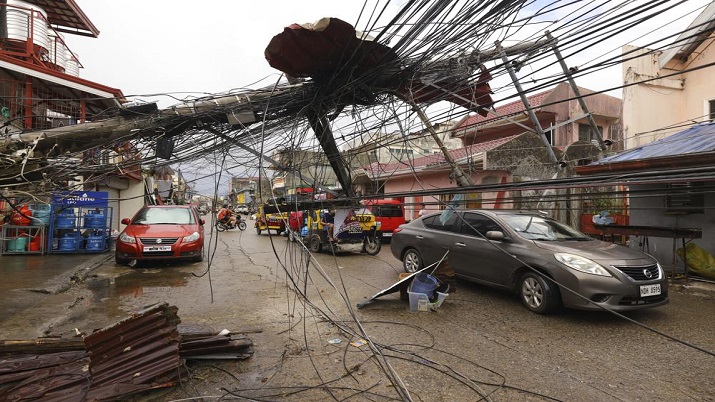
Cars fell from power poles due to Typhoon Rai in the city of Surigao in Surigao del Norte, southern Philippines, due to a power outage.
The death toll has risen to more than 200 after the strongest storm to hit the Philippines this year, with 52 still missing and communication and power outages in several central towns and provinces, officials said on Monday. And water is being requested.
The storm at its strongest packed winds of 195 kph (121 mph) and gusts of 270 kph (168 mph) before blowing into the South China Sea on Friday.
According to the National Police, at least 208 people were killed, 52 remained missing and 239 were injured. The toll was expected to rise as many towns and villages remained inaccessible due to communication, power outages and closed roads, although large-scale clean-up and repair efforts were underway with better weather.
Many of those who died were hit by falling trees or walls, drowned in flash floods or were buried alive in landslides. In Negros Occidental province, a 57-year-old man was found hanging from a tree branch and a woman was blown up by the wind and died in the same difficult area, police said.
Arlene Bagh-Ao, governor of the Dinagat Islands, one of the southeastern provinces that was first hit by the typhoon, said Rai’s brutality in the island province of more than 130,000 was worse than Typhoon Haiyan, which struck It was one of the most powerful and deadliest typhoons on record. and which devastated the central Philippines in November 2013 but no casualties in Dinagat.
“If it was like being in the washing machine before, this time it was like a giant monster that smashed itself everywhere, grabbing anything like trees and tin roofs and then throwing them everywhere,” says Garden -Aao told The Associated Press by telephone. “The wind was moving from north to south to east and west repeatedly for six hours. Some tin roofing sheets were blown off and then thrown back. ,
At least 14 villagers were killed and more than 100 others were injured and treated in makeshift surgery rooms at Dinagat’s damaged hospitals after blown up tin roofs, debris and glass shards, Bagh-Ao said. He said many more people would have died if thousands of residents had not been evacuated from high-risk villages before the storm struck.
Like many other hurricane-hit provinces, Dinagat remained without electricity and communications, and many residents in the province, where the roofs of most homes and buildings were torn down, needed construction materials, food and water. Bagh-Ao and other provincial officials traveled to nearby areas that had cellphone signals to assist and coordinate recovery efforts with the national government.
More than 700,000 people were killed by the storm in the Central Island provinces, with more than 400,000 being taken to emergency shelters. Police, soldiers and coast guards rescued thousands of residents, including in the riverside town of Lobok in Bohol province, where residents were trapped on roofs and trees to escape floodwaters.
Emergency teams were scrambling to restore electricity and cellphone service in at least 227 cities and towns, officials said, adding that three regional airports were also damaged.
Bagh-Ao and other officials expressed concern that their provinces might be short of fuel, which was in high demand due to the use of temporary power generators, including those used for refrigerated warehouses, where Large quantities of coronavirus vaccine stocks were stored. Officials delivered vaccine shipments to several provinces for an intensive vaccination campaign that was postponed last week due to a typhoon.
At the Vatican, Pope Francis expressed his closeness to the people of the Philippines on Sunday, referring to a “storm that destroyed many homes”.
About 20 hurricanes and typhoons affect the Philippines annually, which is located between the Pacific Ocean and the South China Sea. The Southeast Asian archipelago is also located along the seismically active Pacific “Ring of Fire” region, making it one of the most disaster-prone countries in the world.
Read also: Typhoon Rai hits the Philippines, about 100,000 people evacuated
Read also: Death toll in Philippines Super Typhoon Rai rises to 146
,